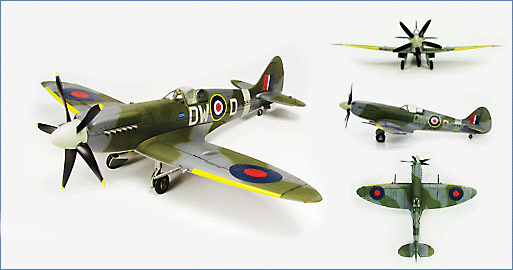Air Power Series>1:48 die-cast display model>Spitfire>HA7102
Spitfire Mk.XIVc, 610 Sqn., Sqn Ldr R. Newbery, June 1944

General Background
Spitfire Mk XIV was the most important Griffon-engined Spitfire. It was powered by a 2,035hp Griffon 65 engine based on the Mk. VIII fuselage. Given its superior performance, the Mk.XIVs were used extensively to intercept the high speed V-1 flying bombs from Germany. In the European continent the aircraft was mainly used as armed reconnaissance searching for enemy targets.
Probably one of the best-known fighters of WWII the Spitfire had a big psychological effect at home and in Germany. With its great performance the British were given hope of surviving the Battle of Britain and the German pilots learned to respect its fighting capabilities. It wasn't the workhorse the Hurricane was but the great handling capabilities along with its great looks made the Spitfire a WWII icon. The plane was also used very successfully in a reconnaissance role and was the only Allied fighter in production for the entire WWII years.
Probably one of the best-known fighters of WWII the Spitfire had a big psychological effect at home and in Germany. With its great performance the British were given hope of surviving the Battle of Britain and the German pilots learned to respect its fighting capabilities. It wasn't the workhorse the Hurricane was but the great handling capabilities along with its great looks made the Spitfire a WWII icon. The plane was also used very successfully in a reconnaissance role and was the only Allied fighter in production for the entire WWII years.
The Aircraft
The 610 Squadron formed at Hooton Park in Cheshire in 1936 as part of the Royal Auxiliary Air Force. January 1939 saw them re-designated as an RAF fighter squadron. In 1944 the 610 was the first to receive the new Spitfire XIVs. The new Griffon powered aircraft arrived when the V-1 rockets started and used their speed to chase down and destroy them. The 610 Squadron destroyed 50 V-1s with 1/5 going to S/L Richard A. Newbery DFC flying DW-D RB159. Newbery was C/O of 610 Squadron January 1944 – February 1945. With long range fuel tanks 610 flew missions over Germany.
610 Squadron motto "Alifero tollitur axe ceres"; which translates as "Ceres rising in a winged chariot". Ceres being the Roman Goddess of Wheat, a reference to Chester's Agricultural sector. Its badge contained the image of a sheaf of wheat.
610 Squadron motto "Alifero tollitur axe ceres"; which translates as "Ceres rising in a winged chariot". Ceres being the Roman Goddess of Wheat, a reference to Chester's Agricultural sector. Its badge contained the image of a sheaf of wheat.
Specifications :
| Basic Information : | |
| Country of origin: | Britain |
| Classification: | single-engine fighter |
| Crew: | 1 |
| Production: | first produced in 1943 |
| Number produced: | 950 of all XIV variants |
| Dimensions: | |
| Wingspan: | 36ft 10in (11.23m) |
| Length: | 32ft 8in (9.96m) |
| Performance: | |
| Powerplant: | 1 X Rolls-Royce Griffon 65 12 cylinder liquid-cooled engine 2,035hp (1,517kW) |
| Speed max: | 447mph (720km/h) |
| Range: | 460 miles (740 km) on internal tanks |
| Ceiling max: | 42,978ft (13,100m) |
| Weight: | |
| Empty: | 6,603lb (2,995kg) |
| Maximum: | 10,285lb (4,665kg) |
| Armament: | 2 X 20mm (.078in) Hispano cannons |
| 4 X Browning 7.7mm (0.303in) machine guns | |
| Up to a 1,000lb (454kg) payload with other options possible |

